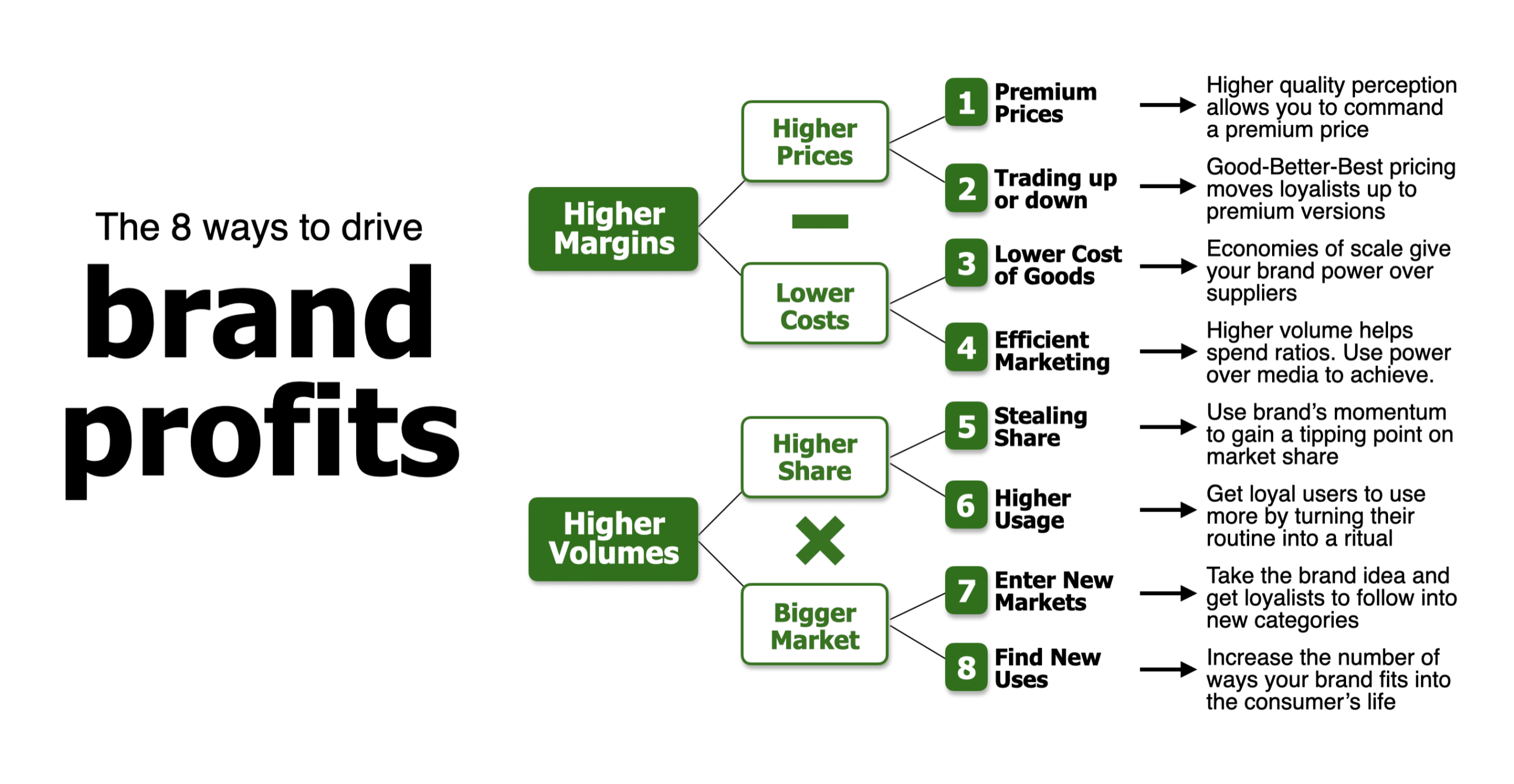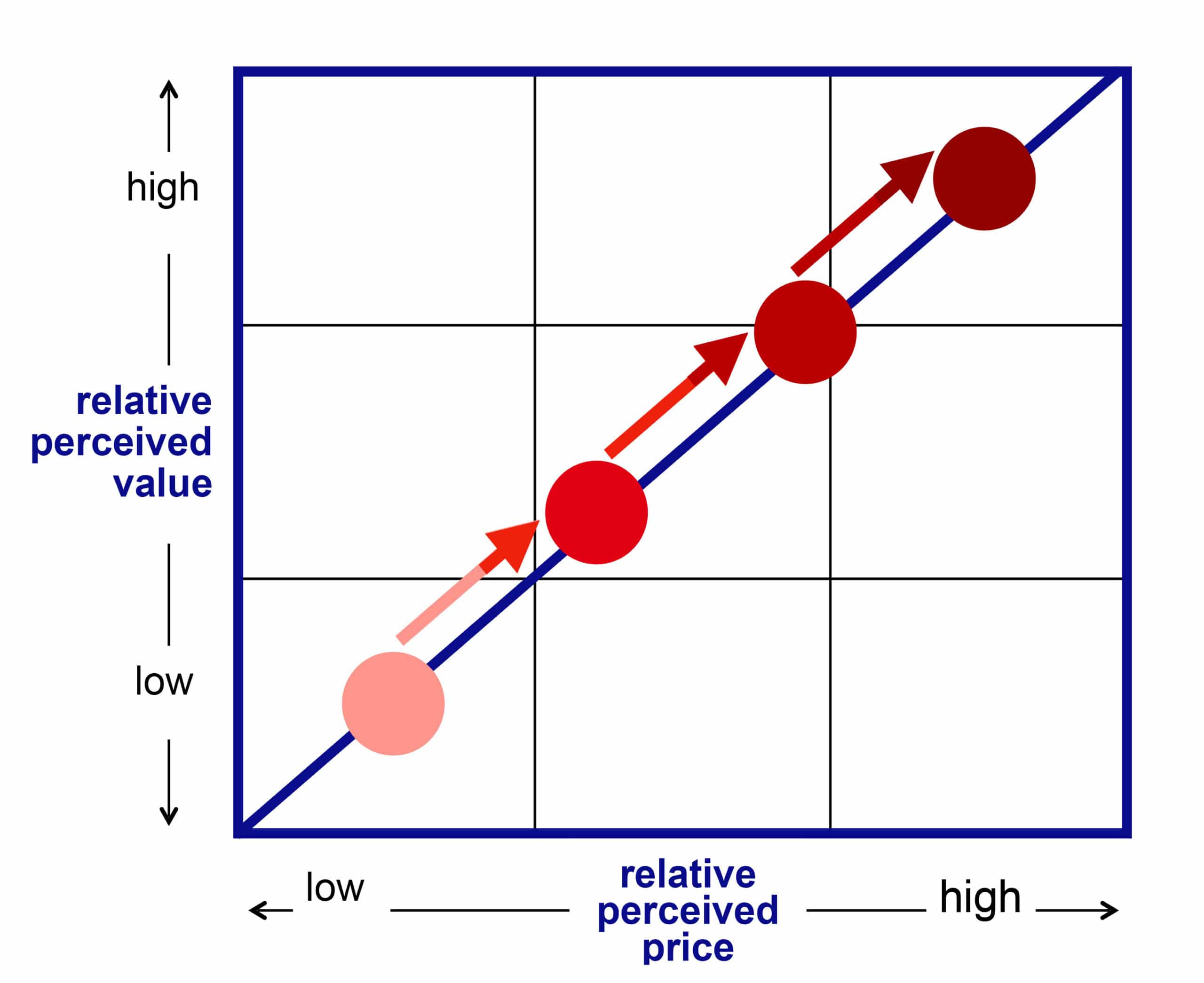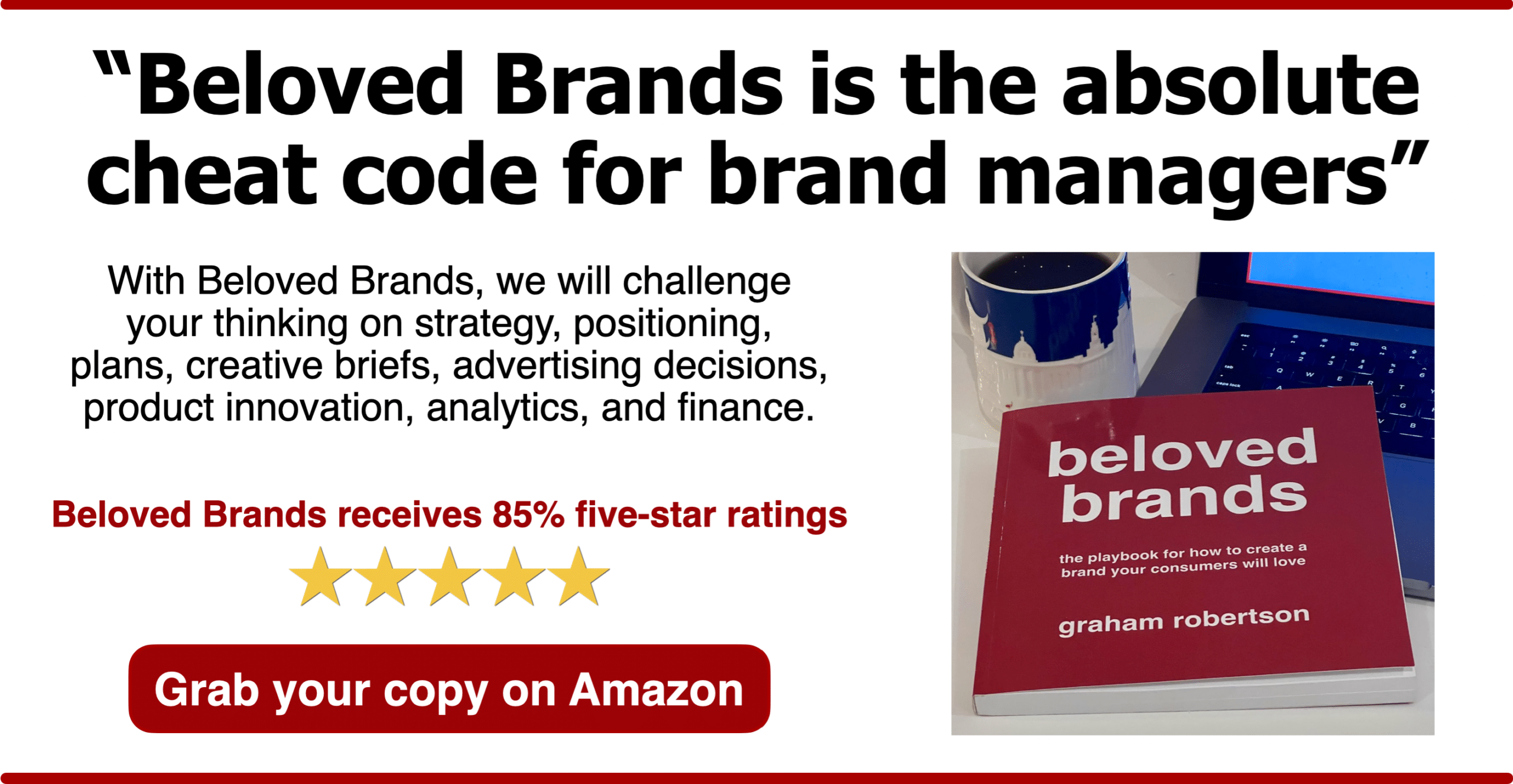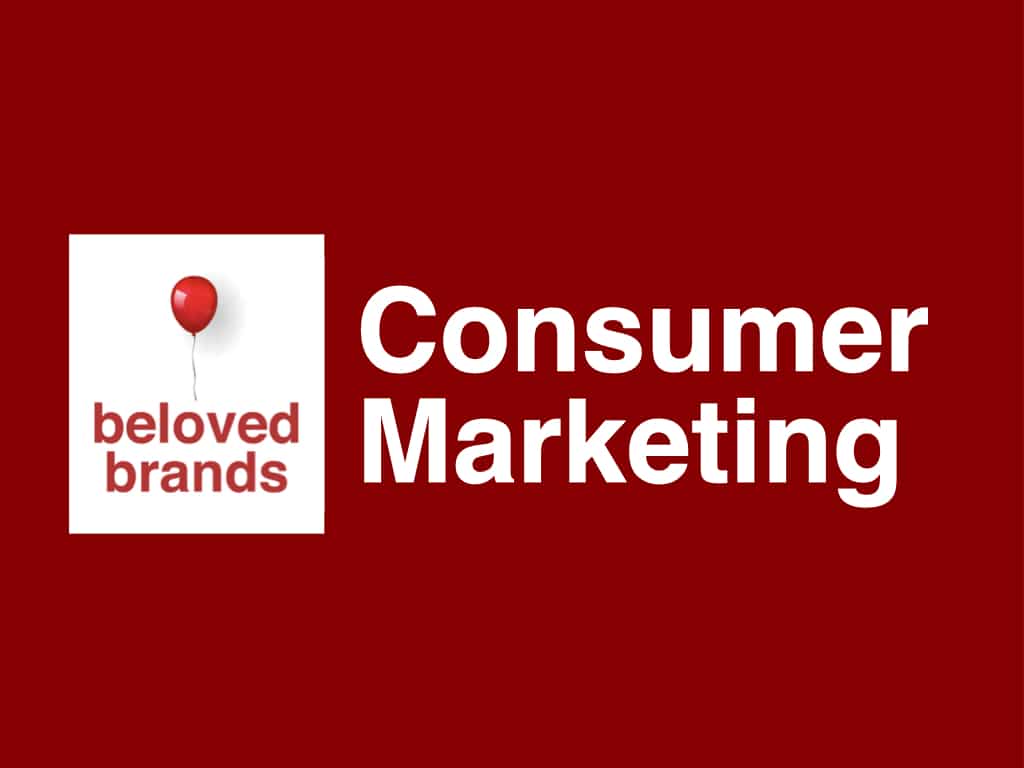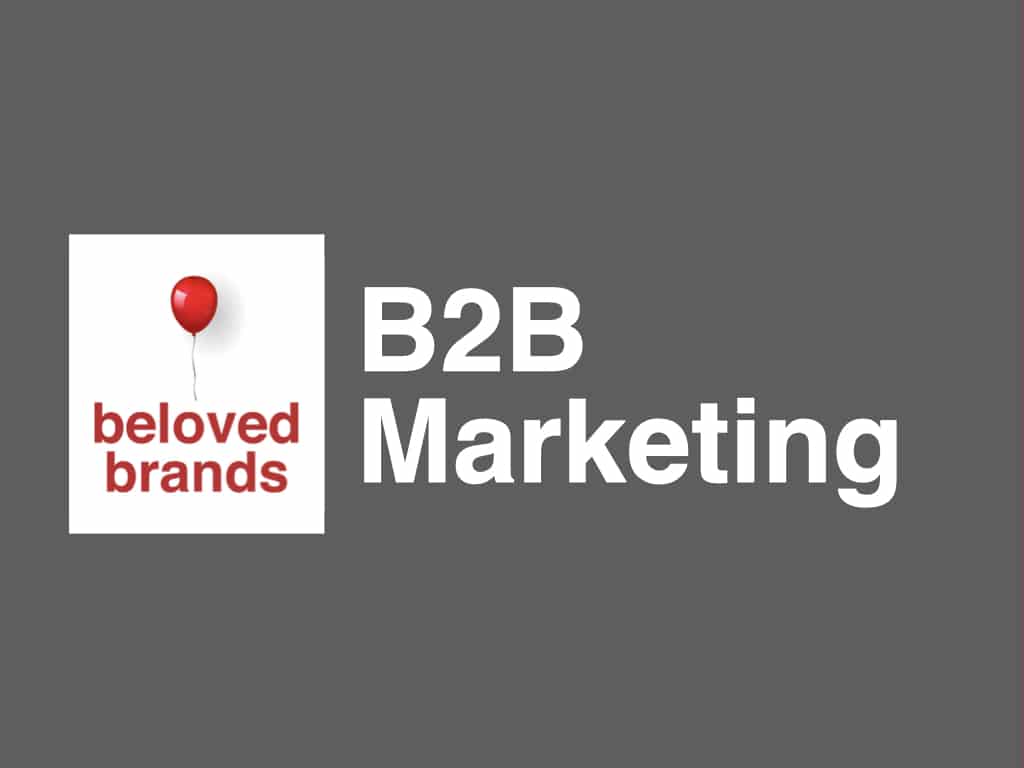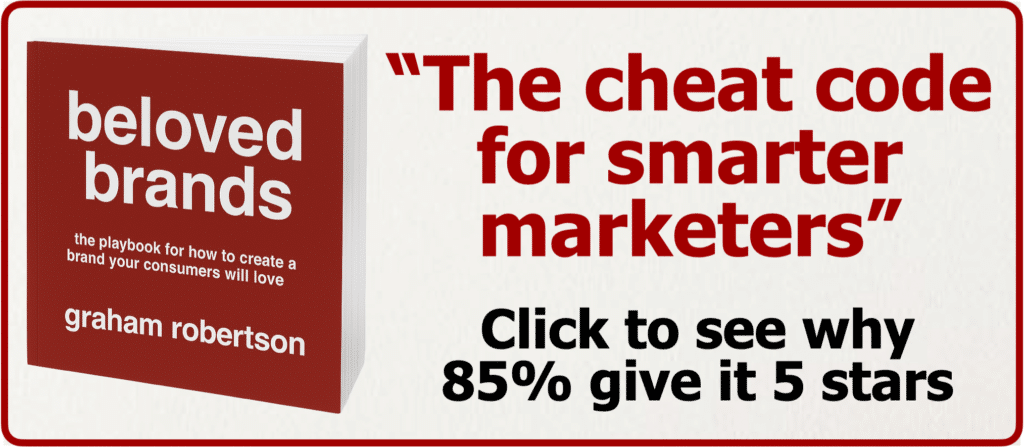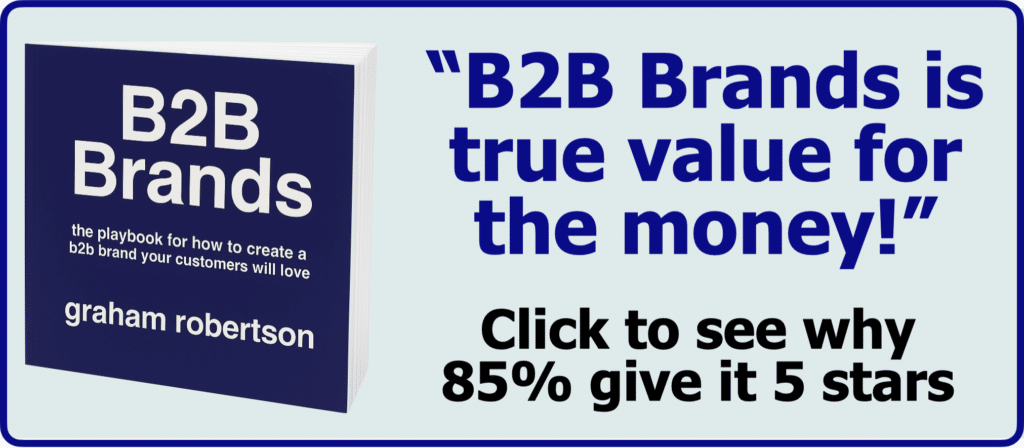The best marketers are equally good at strategy, creativity, and the numbers connected to their brand. If you are in marketing, you must understand how everything you do is linked to brand profit. You know what drives price. In additon, you need to know how to manage costs. If you are not looking at brand profitability, then you will be stuck working for someone who is. This article is part of our Marketing Finance series.
“Advertising people see art. Finance people see numbers. The best marketers see art and numbers at the same time.”
To illustrate, click on the diagram above to view the 8 ways to drive brand profits.
The marketing fundamentals matter
We have created a Brand Toolkit that includes every slide you need to run your brand. If you are looking to build out your marketing plan, you can engage our Marketing Plan template. If you are looking to find the right brand positioning on your brand, we do run consulting workshops with teams to help come up with the ideal solution. We teach marketing finance as part of our marketing training and our Mini MBA.
Brand finance
Eight ways to drive brand profits
While good marketers can run brands and marketing programs, great marketers will drive brand profitability. As part of marketing finance, here are eight ways the Brand Leader can drive brand profits:
- Premium pricing
- Trading the consumer up or down
- Product Costs
- Efficient Marketing Costs
- Stealing other users
- Getting current users to use more
- Enter new categories
- Create new Uses for your brand
Premium pricing
While many marketers think of price as a defensive reaction, most times to counter inflation or something happening in the trade channels, marketers should refocus and start using price as a weapon to drive Brand Value. Beloved brands seem more capable at driving profits through pricing, but they also are careful to ensure the premium does not become excessive to create backlash.
Price Increase.
You can do a price increase if the market or brand allows you. It likely has to be based on passing along cost increases. Factors that help are whether you are a healthy brand or it’s a healthy market, as well as the power of your brand vs. competition and channel.
Price Decrease.
Used when fighting off competitors if you need to react to a sluggish economy or channel pressure. Another reason to decrease price is if you have a competitive advantage around cost, whether that’s manufacturing, materials, or distribution.
There are watchouts for price changes. It’s difficult to execute, especially if it has to go through retailers. You need to understand power relationships–how powerful are the retailers? Moreover, retailers often scrutinize price changes so badly that you must have proof of why you are doing it. It’s likely your Competitors will over-react. So, your assumptions you used to go with the price increase will change right after. And finally, it’s not easy to change back.
Trading consumers up
Aside from price increases, another strategy to drive profit is to create a range of products that allows you to reach up or down to a new set of consumers. You need to ensure that you are doing this for the right reason or it could backfire on you.
Trading Up.
If you have a range of products, sometimes it can be beneficial to get consumers to trade up. Can you carve out a meaningful difference to create a second tier that goes beyond your current brand? Do your brand image/ratings allow it?
Trading Down.
Risky, but you see un-served market, with minimal damage to image/reputation of the brand. In a tough economy, it might be better to create a value set of products rather than lower the price on your main products.
There are a few watch outs around trying to trade up or down: Premium skus can feel orphaned at retail world—on the shelf or missing ads or displays. Managing multiple price levels can be difficult—what to support, price differences etc. For all the effort you go to, make sure your margins stay consistently strong through the trading up or down. Be careful that you don’t lose focus on your core business. You can’t be all things to everyone. The final concern is what it does your Brand’s image, especially risky when trading downward.
How to use your pricing strategy to drive brand growth and brand profit.
Your pricing strategy plays a significant role in driving your brand growth. You need to treat pricing as a continuous process to project your brand positioning and stay competitive. Match your pricing strategy to your overall business strategy and financial objectives. Think of how you set up your business to make money and the role price plays in delivering those results.
Product Costs
Managing product costs can be a weapon to enhance the brand’s value. It can be either your cost of goods or the marketing costs. As marketers, we sometimes think the cost is someone else’s job. But it’s an effective weapon that marketers should be utilizing.
Cost of Goods Decreases.
You can use the power of your brand to drive power over your suppliers; you find cheaper potential raw materials, process improvement, or find off-shore manufacturing.
Cost of Goods Increases.
Make sure that you manage the COGs as they increase. Watch out for suppliers trying to pass along costs. But realize that with new technology, investing in the brand’s improved image, going after premium markets, offering new benefits, or a format change, the cost of good increases could be a reality.
The watch outs with managing costs: with cuts, make sure the product change is not significantly noticeable. You should understand any potential impact in the eyes of your consumers on your brand’s performance and image. Importantly, explore whether the P&L covers these costs, either increased sales or efficiency elsewhere. Managing your margin % is crucial to the long-term success of your brand. It’s all about managing the overall brand profit.
Marketing Costs
Marketers are protective of marketing budgets. They usually want as much money as possible to carry out the activities on their priority list. The strategic brand leader should act as the owner/CEO by using budgets to manage the brand profit rather than act like a subject-matter expert trying to protect their turf.
Marketing cost decrease:
Companies often look at cost-cutting to counter short-term changes within other parts of the P&L (price, volume, or COGs). However, many best-run brands keep the investment strong, aligning with the longer-term strategy instead of a short-term situational need.
Marketing cost increase:
Used when there is an opportunity to gain share against a competitor or as a defensive position trying to hold share. The brand should see an opportunity where significant revenue gains can cover the lower profit ratios.
Use your strategic thinking to determine your marketing budget level. How connected your brand is with consumers determines where on the consumer journey you will focus. For an indifferent or liked brand, you should focus on driving awareness and purchase, which are usually expensive. As you get to be more loved, you can concentrate on turning repeat purchases into routines. You can shift some of the marketing budgets to create a superior consumer experience to reward your loyal users. The more loved a brand, the better the spend-to-sales ratios you should realize. This is your chance to manage the brand profit.
Steal other users
Externally, the share and volume game are traditional tools for brands who want to increase brand profit. Either stealing other users or getting current users to use more.
Offensive Share Gains.
Use it when you have a significant Competitive Advantage or see untapped market needs. Or opportunistic, use first mover advantage on new technology.
Defensive Share Stance.
Hold the fort until you can catch up on technology, maintain profitability, loyal base of followers needs protecting.
Be careful when trying to gain share. A beloved brand has a drawing power where it gains share without using attack modes. Attacking competitors can be difficult. It could just become a spend escalation with both brands just going at it. After a share war that’s not based on substantive reasoning (e.g. technology change), there might be no winners, just losers. The channel often tries to play one competitor against another for their own gain. Watch out for what consumers you target in a competitive battle: some may just come in because of the lower price and return to their usual brand.
Get users to use more
Share of Requirements.
Going after frequency is a different strategy to increase brand profit. In many categories, even loyal consumers will work within a competitive set of favorite brands. A good strategy is to provide a reason (claim, experience, emotion) for loyal consumers to stay with your brand.
Get Current Users to Use More.
When there is an opportunity to turn loyal users into creating a potential routine, changing behaviors is more difficult than enticing trial. It’s a good strategy to use when there’s a real benefit to your consumer using more. It’s hard to get them to use more without a real reason.
There has to be a real benefit connected to using more, or it might look hollow/shallow. Driving routines are a challenge. Even with “lifesaving” medicines, the biggest issue is compliance. Find something in their current life to help either ground it or latch onto it.
When I worked on Listerine, people only used mouthwash 20-30 times a year compared to 700+ brushing occasions. So, we focused on connecting rinsing with Listerine to the twice-daily brushing routine.
Enter new categories
You can increase brand profits by entering new categories with an untapped or under-served need. There could be a significant changing demographic that impacts your base.
Or you can translate/transfer your reputation to a new user group. There should be something within your product/brand that helps fuel the brand post-trial. Trial without repeat means you’ll get the spike but then bust. Substantial investment is required. Don’t let it distract from protecting the loyal users.
Create new uses
You can drive brand profits through format line extensions that take your experience or name elsewhere. Can you leverage the same benefit in a convenient “on-the-go” offering? Ensure the current brand is in order before you divert attention, funding, and focus on expansion areas. Importantly, the investment needed could divert from spending on base business.
However, be careful because the legendary stories (Arm and Hammer) don’t come along as much as we hope.
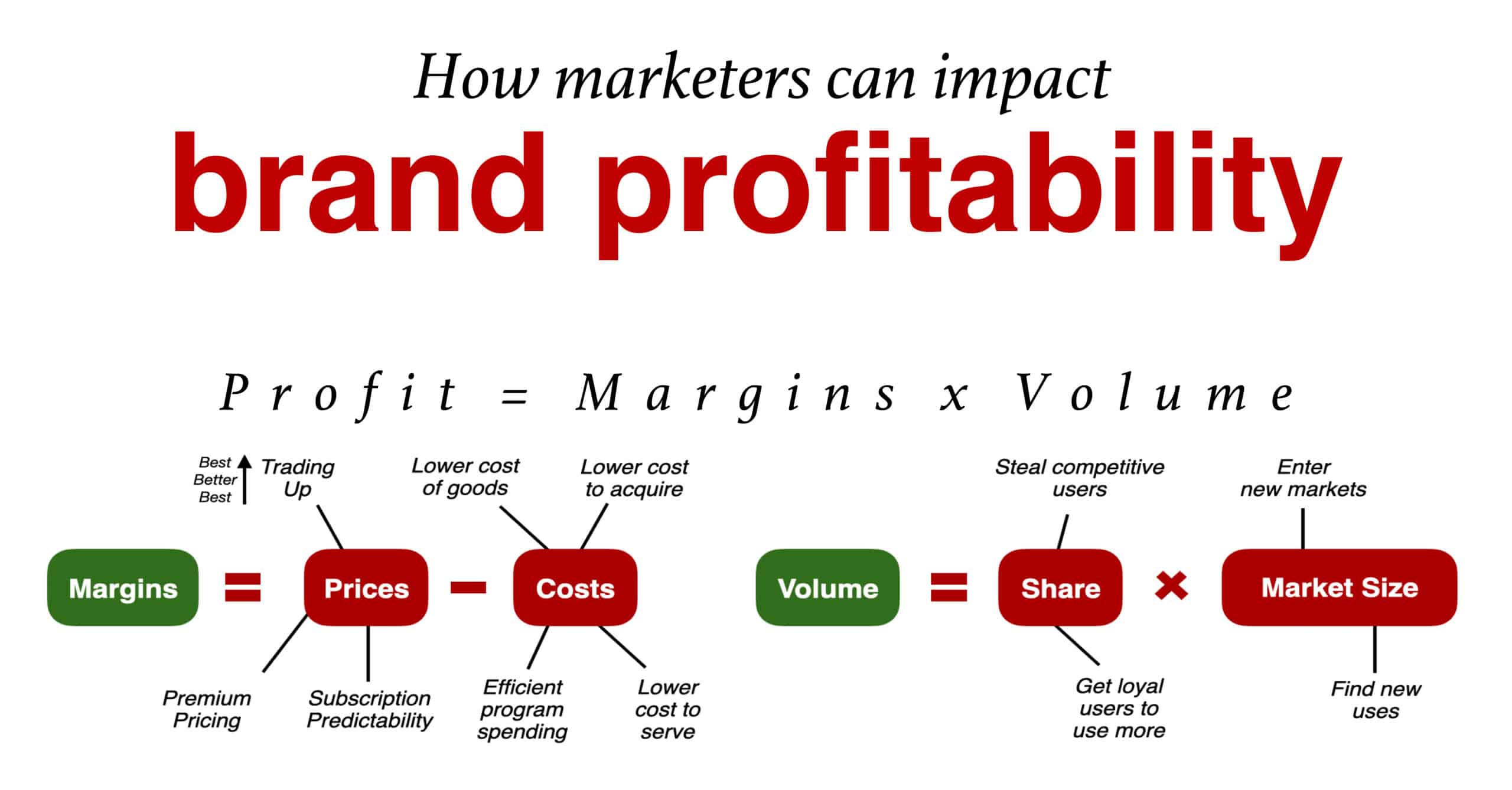
To illustrate, click on our brand profitability diagram to zoom in.
What type of marketer are you?
We believe that marketers learn best when they see our marketing concepts applied to brands that look like their own. We have come up with specific examples – consumer, B2B and healthcare – to showcase our marketing tools. Click on the icon below to choose your interest area.
Beloved brands drive strong sales growth, which helps the profit and loss statement work harder and more efficiently.
With all the love and power the beloved brand has generated for itself, now is the time to translate that into growth, profit, and value. The beloved brand has an inelastic price. The loyal brand fans pay a 20-30% price premium and the weakened channels cave to give deeper margins. We will see how inelastic Apple’s price points are with the new iPad Mini.
Consumers are willing to trade up to the best model. The more engaged employees begin to generate an even better brand experience. For instance at Starbucks, employees know the names of their most loyal of customers. Blind taste tests show consumers prefer the cheaper McDonald’s coffee but still pay 4x as much for a Starbucks. So is it still coffee you’re buying
A well-run beloved brand can use their efficiency to lower their cost structure.
Not only can they use their growth to drive economies of scale, but suppliers will cut their cost just to be on the roster of a Beloved Brand. They will benefit from the free media through earned, social, and search media. They may even find government offer subsidies to be in the community or partners willing to lower their costs to be part of the brand.
For instance, a real estate owner would likely give lower costs and better locations to McDonald’s than an indifferent brand. Apple get a billion dollars worth of free media, with launches covered on CNN for 2 weeks prior the launch and carried live like it’s a news event.
Beloved brands have the momentum they can turn into share gains.
Crowds draw crowds which spreads the base of the loyal consumers. Putting the Disney name on a movie generates a crowd at the door on day one. Competitors can’t compete–lower margins mean less investment back into the brand.
It’s hard for them to fight the Beloved Brand on an emotional basis leaving them to a niche that’s currently unfulfilled. Walk past an Apple store 15 minutes before it’s open and you’ll see a crowd waiting to get in–even when there are no new products.
Beloved brands can enter into new categories knowing their loyal consumers will follow because they buy into the Idea of the brand. The idea is no longer tied to the product or service but rather how it makes you feel about yourself. Nike is all about winning, whether that’s in running shoes, athletic gear, or even golf equipment.
Knowing your profit impact.
Higher volume helps you exert pressure on costs. That could be supply costs, operations costs, and distribution over even media costs.
Get more for less from the trade. You can begin exerting power over the sales channels to your advantage–trimming variable trade costs with retailers while demanding more display, prime real estate, coop advertising, and more control over pricing. ROI on trade programs.
Smarter more efficient management.
Manage your inventories, meet customer expectations, control pricing, and drive cheaper costs. Growth means you start outgrowing any fixed costs. This includes start-up costs, sales force, product plants, or R&D costs. Lower cost of capital: More certainty means lower risk and you can re-invest, knowing the ROI will be quicker and stronger.
Marketing Finance 101
If you would like to read more about our marketing finance 101 and how to dissect your financial statement, this article is part of our series to help you manage your brand profitability.
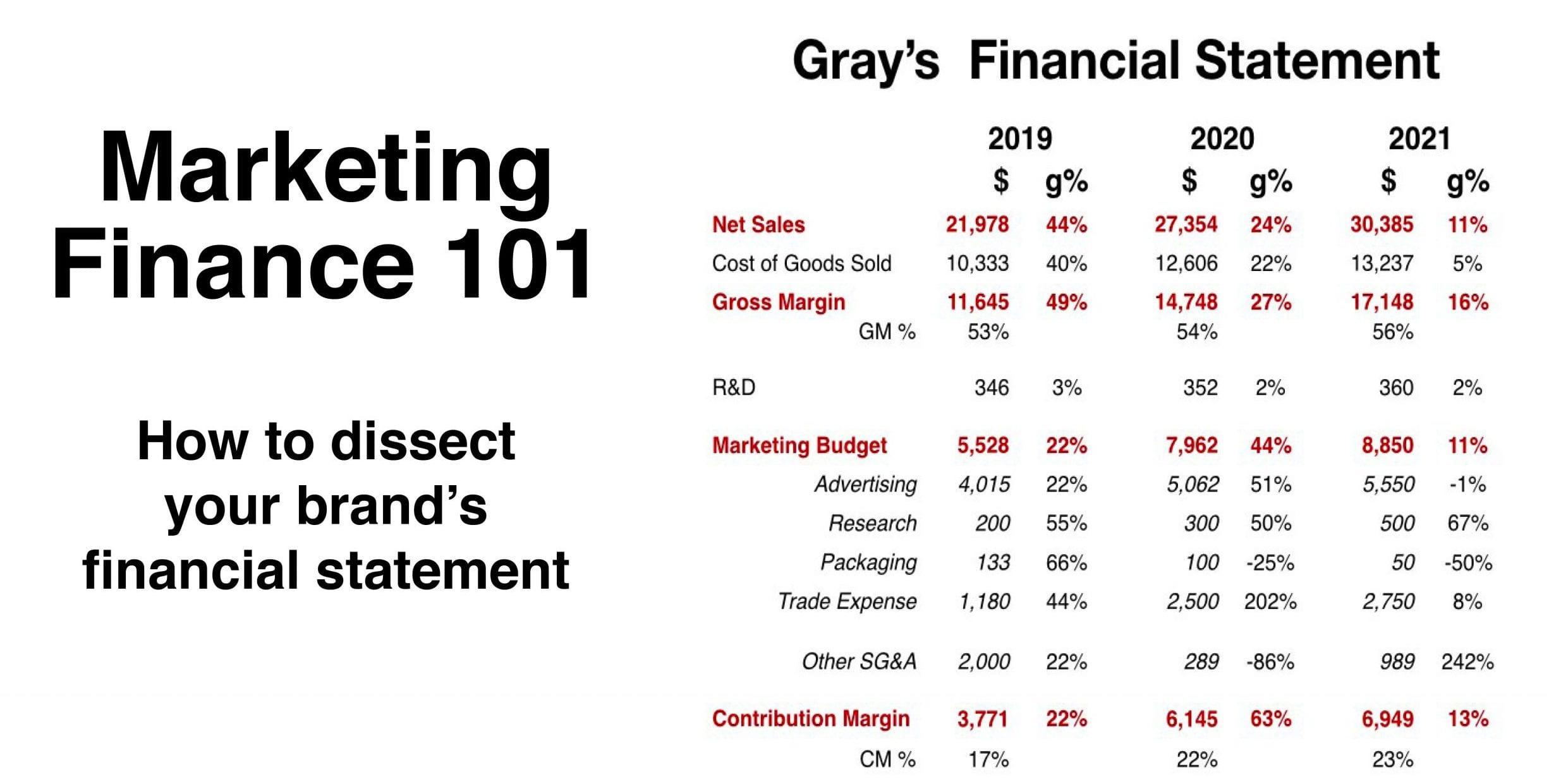
How to manage a portfolio of brands
Portfolio Management is an investment strategy to deliver maximum payback for the company using a collection of brands.
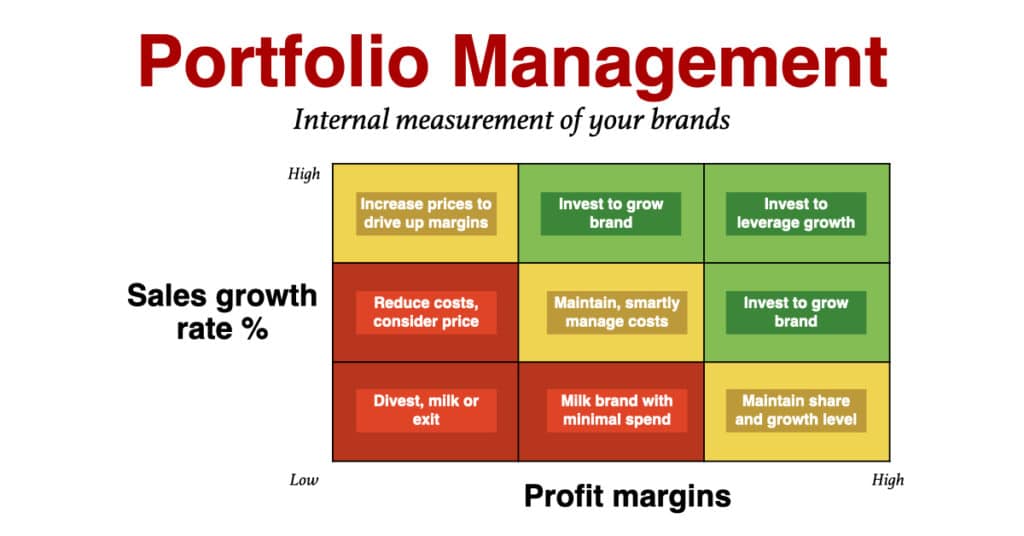
A portfolio of brands requires a diverse set of investments. Each brand needs to be carefully selected to meet specific goals. Marketing Finance 101 helps marketers allocate their budget to achieve the desired goals across the portfolio, which requires an external and internal view. Portfolio management must help drive brand profits.
This article is part of our series to help you manage your brand profitability.


